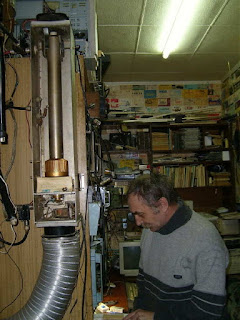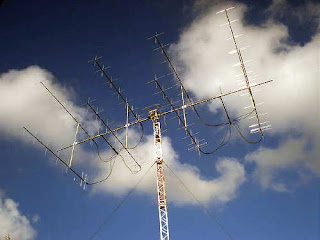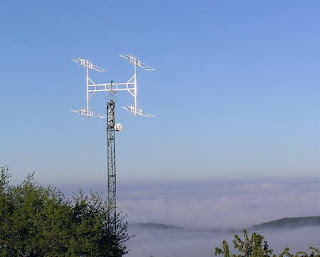 The Spectrum Monitor — March, 2016
The Spectrum Monitor — March, 2016
 Stories you’ll find in our March, 2016 issue:
Stories you’ll find in our March, 2016 issue:
2016 TSM Air Show Special
By Brian and Jo Marie Topolski
Monitoring the action in the air at any of North America’s many air shows can be daunting. You have to know where to listen and when to listen to fully enjoy the spectacle. Veteran air show attendees and TSM contributors, Brian and Jo Marie Topolski, give us some valuable hints about air show action. Don’t forget to bring your scanner, camera and ear protection—it’s going to get really loud!
Flying with Fat Albert and Sean D. Tucker
By Kevin Burke
Longtime air show attendee, photographer and veteran air-band monitor, Kevin Burke, has found himself in several uncomfortable situations, all in pursuit of a great shot of some of the world’s most advanced aircraft in action. Whether it’s a nausea-inducing ride in a C-130 doing aerobatic maneuvers or hanging from a seatbelt in a support plane watching Sean D. Tucker tear up the skies in his 400-horsepower biplane, Kevin is in the game!
How to Track Military and Civilian Aircraft on your Home Computer
By Larry Van Horn N5FPW
Monitoring military and civilian aircraft activities via your scanner has come a long way. Not too long ago it was the domain of well-heeled hobbyists with highly honed technical skills. Now, thanks to off-the-shelf receivers and readily available software, you can personally keep track of almost anything that flies, almost anywhere in the world. Veteran milcom monitor, Larry Van Horn, shows us how it’s done.
A Beginner’s Guide to Monitoring Aviation
By Dave Kelly
Air comms in the sky aren’t just for private and commercial aviation; the military provides some of the more interesting action you can hear. And, it’s not just VHF and UHF frequencies you need to monitor. Dave walks us through the basics of aviation monitoring with tips on where and when to tune in. And, here’s a hint, you don’t have to live near a major airport or military base to hear something interesting.
2016 TSM Air Show Guide
From March through November the best precision aircraft and skydiving teams will be in the air at an airbase near. Here are the 2016 schedules for the US Air Force Thunderbirds; the US Navy Blue Angels; the Canadian Forces Snowbirds; US Army Golden Knights; Breitling Jet Team; Team Oracle Presents Sean D. Tucker, and GEICO Skytypers as provided by each team.
Scanning America
By Dan Veenaman
Michigan Interoperability System; Rebanding Progress
Federal Wavelengths
By Chris Parris
Federal Monitoring at Super Bowl 50
Utility Planet
By Hugh Stegman NV6H
ALE: The Mode that Linked the World
Digital HF: Intercept and Analyze
By Mike Chace-Ortiz AB1TZ/G6DHU
Is an Egyptian HF Diplomatic Network Overhaul Underway?
HF Utility Logs
By Mike Chace-Ortiz and Hugh Stegman
Digitally Speaking
By Cory Sickles WA3UVV
What Else Can You Do With It?
VHF and Above
By Joe Lynch N6CL
The History of the VUCC Award
Amateur Radio Insights
By Kirk Kleinschmidt NT0Z
Forgotten Antenna Fundamentals and Other Curious Tidbits—Part 3
Radio 101
By Ken Reitz KS4ZR
The Goodwill Radio Connection
Radio Propagation
By Tomas Hood NW7US
The Somersaulting Sun
The World of Shortwave Listening
By Keith Perron
Radio Netherlands: Archiving Shortwave Radio History
The Shortwave Listener
By Fred Waterer
DJs, The Bard, and “My Favorite Country”
Amateur Radio Satellites
By Keith Baker KB1SF/VA3KSF
AMSATs Then and Now
The Longwave Zone
By Kevin O’Hern Carey WB2QMY
News, Mail, and Updates
Adventures in Radio Restoration
By Rich Post KB8TAD
Another Lafayette Radio: New Life for an HA-230
Antenna Connections
By Dan Farber AC0LW
Antenna Stealth: A Working Philosophy
Radio Horizons
Teak Air Show Guide 2016 17th Edition by Larry Van Horn N5FPW
The Spectrum Monitor is available in PDF format which can be read on any desktop, laptop, iPad®, Kindle® Fire, or other device capable of opening a PDF file. Annual subscription is $24. Individual monthly issues are available for $3 each.
Ken Reitz, KS4ZR, is publisher and managing editor of The Spectrum Monitor. Contact him at editor@thespectrummonitor.com.
 Making the Palm Mini Paddle Stay Put
Making the Palm Mini Paddle Stay Put
In my on-going quest to produce a lightweight yet good-performing kit of portable equipment to carry along on my exotic work travels, I set my sights once again upon the Morse keying paddles. When I was a student, I carried what I had: a black-base Bencher BY-1. This caught the attention of nearly every airport security screener and was obviously quite heavy, but it stayed put on the table (for the most part) when I aggressively worked a pileup. A few years back, my wonderful, loving, and patient wife, solicited suggestions for Christmas gifts and I suggested a Palm Radio Mini Paddle. (She’s grateful when I provide a link to a web site with a shopping cart in these situations.)
The Palm is really a joy to use and is extraordinarily lightweight, which is perfect for travel. However, I’ve always struggled with how to keep it steady on a table. I have the magnetic base, but that presupposes a ferromagnetic surface to which it will mount. Since both the Elecraft K3 and K2 have aluminum panels, I can’t count on the radio. I tried a variety of additional things, up to and including, trying to design a 3D-printed carrier that is akin to the Begali Traveler. So, I shelved the project, only using the Palm key for casual portable operating when mass trumped long-term operating comfort and efficiency. Good fortune happened upon me and I built this.
When I decided to add an amplifier (more on this in the future) to my portable setup, again pressure set in on the mass of everything. So, I revisited the Palm Mini project. I had purchased a number of mounting clips for the key (hedging my bets against the ephemeral nature of ham radio businesses); so, I set out to attach one to the K2. I’d seen the photo of the base attached to the right-hand side panel of the K2 by the power switch. But, I really didn’t want to drill holes in the panel, plus that puts the paddles too high when the tilt bail is raised (which is necessary to see the display).
So, I fabricated two strips of 3/16-inch aluminum plate (leftover from the hexagonal beam I built a few years ago) with a hole bored down between them to clamp on the tilt bail of the K2 or the K3. There’s nothing particularly critical about the construction of it, although I used a Bridgeport mill to do all the cutting; you might be able to do it in a drill press. I think I ended up with a #14 drill for the clamp hole. I used 6-32 hardware because I had it on-hand and I like the bigger stuff. I had to enlarge the adjustment slot in the Palm base to handle the bigger diameter.
Ethan Miller, K8GU, is a regular contributor to AmateurRadio.com and writes from Maryland, USA. Contact him at ethan@k8gu.com.
 LHS Episode #163: Let’s Get Astrophysical
LHS Episode #163: Let’s Get Astrophysical
 Hello, listeners! Another universe-shattering episode of Linux in the Ham Shack is upon you. During this little slice of now, your hosts discuss the safety of wireless networking, colliding black holes, a popular Linux distro site being hacked, a tablet Linux OS, browser-based logging applications, ChromeOS on the Raspberry Pi and much more. Time is running out! Please donate to our Generosity campaign. We want you to see us at Hamvention this year. Thank you!
Hello, listeners! Another universe-shattering episode of Linux in the Ham Shack is upon you. During this little slice of now, your hosts discuss the safety of wireless networking, colliding black holes, a popular Linux distro site being hacked, a tablet Linux OS, browser-based logging applications, ChromeOS on the Raspberry Pi and much more. Time is running out! Please donate to our Generosity campaign. We want you to see us at Hamvention this year. Thank you!
73 de The LHS Crew
Russ Woodman, K5TUX, co-hosts the Linux in the Ham Shack podcast which is available for download in both MP3 and OGG audio format. Contact him at russ@bluecows.com.
 Single Yagi Moonbounce
Single Yagi Moonbounce
 |
| courtesy: JPL/NASA |
In early 2007, I decided to try 2m moonbounce using WSJT's JT65B digital mode. Over the years, moonbounce has gradually drifted away from CW to the much less demanding weak signal digital mode, allowing smaller stations to still explore the excitement of exchanging signals via reflection from the lunar surface. I am fortunate to have an excellent QTH for such an endeavour, being located beside the ocean with a saltwater horizon favoring moonrises, especially during the winter months of more northerly lunar declinations.
 |
| Moonrise from front yard |
I soon realized that the actual numbers appeared very close to predicted values and using an inexpensive 2m FM/SSB 'brick amplifier' (with built-in GasFet preamp) delivering approximately 140 watts, I was able to work 54 different stations over the next twelve months. All of the stations worked were doing the heavy lifting, with the majority running typical 4-yagi H-frame arrays using yagis from 6 to 17 elements each. I did work one station that was using two small yagis during a period of excellent conditions. Somewhat surprisingly, a large majority of the stations I worked were strong enough to be heard audibly from the transceiver's speaker.
I'm always amazed at the truly small amount of RF energy that is actually left, after the round trip to the moon ... yet information can still be exchanged. On 144MHz, the round trip losses are a minimum of 250db. Factoring-in my antenna's gain and ignoring the coaxial losses in 70' of RG213, there is a scant 1.56 x10^-9 W arriving at the moon ... that's .00000000156 W! Considering how much RF is absorbed in the lunar dirt and what's left over for the -125db home trip, it's a miracle that some signals are loud enough to be heard by ear at all. EME is really one of ham radio's most fascinating activities.
Reacquainting myself with the newer version of the JT65B software, and testing out the system, I was ready to go on the next evening's moonrise. Unfortunately the moon was rising just a little too far south to give me a really clear shot and I would be pointing into the next door neighbour's trees. Being unable to track the elevation, my operating time is limited to about two hours per session, over a period of several successive days (or nights).
Almost coincidental with the night's moonrise, I heard the strong signals of RX1AS (Alex) in St. Petersburg, calling CQ. I called him and he came right back with my signal report. His station is shown below, along with his large homebuilt strip-line amplifier.
 |
| RX1AS |
The following evening, the moon was buried even deeper into the trees but initials #56 and #57 were worked ... YL2GD (Gunars), in northern Latvia and RX3A (Nikolay), in Moscow city.
 |
| YL2GD and his EME station |
 |
| RX3A's 2m EME array |
Nikolay was worked with the moon at 11 degrees above the horizon. I'm not sure just what my upper limit for lunar elevation might be with this small antenna but the highest elevation I have worked anyone was at 18 degrees.
The third night found less activity on the band as well as a more southerly moonrise, burying my target even further into the neighbour's trees. Few signal were heard but one contact was easily completed with I3MEK (Mario), near Venice ... initial #58.
 |
| I3MEK's 4-yagi 2m EME array |
 |
| I3MEK's 2m JT65b signal |
With so many larger (four or more yagis) stations around the world, a huge antenna is not needed to have success on 2m JT65B moonbounce ... nor is an over-the-ocean moonrise. I've also been able to work stations on moonset where I am pointing over hilly terrain and trees, nowhere near the ocean.
The WSJT (JT65B mode) software is freely available and very easy to implement, but spend some time reading the manual and playing with the software first, perhaps getting used to QSO procedures on 20m.
If you are running a small FM/SSB amplifier on 2m, such as the typical 'brick' I have been using, make sure to add a blower to keep the heatsink cool, as JT65 has a 100% duty cycle and these small amplifiers can get hot pretty fast. I use a small squirrel-cage blower from an old microwave oven to direct a blast of air onto the cooling fins.
Wondering where to point your antenna? One handy site that will provide the moon's position in the sky, for any time and any location, is the U.S. Naval Observatory's 'Sun or Moon Altitude/Azimuth Table'. As well, you can keep abreast of real-time activity or set up skeds, via NØUR's Ping Jockey JT65 EME page.
If you do decide to give this a shot, I'd be interested to hear how you do ... maybe your system is big enough already to let us work each other via the moon.
Steve McDonald, VE7SL, is a regular contributor to AmateurRadio.com and writes from British Columbia, Canada. Contact him at ve7sl@shaw.ca.
 Australian ham gives an insider’s tour of his antennas
Australian ham gives an insider’s tour of his antennas
 Rob Wagner, VK3BVW, gives an interesting and visually appealing tour of the antennas at his home in Mount Evelyn, Victoria, a small town in southeast Australia near the beautiful city of Melbourne.
Rob Wagner, VK3BVW, gives an interesting and visually appealing tour of the antennas at his home in Mount Evelyn, Victoria, a small town in southeast Australia near the beautiful city of Melbourne.
His backyard features mostly wire antennas — 3 are double bazookas (or coaxial dipoles) — and includes a Par SWL End-Fedz antenna.
In addition to creating well-done ham radio videos, VK3BVW writes a blog called the Mount Evelyn DX Report.
Matt Thomas, W1MST, is the managing editor of AmateurRadio.com. Contact him at editor@amateurradio.com.
 Spring is nearly in the air, the new HF rig is ordered and on the way.
Spring is nearly in the air, the new HF rig is ordered and on the way.
Obviously I have been a long time fan of Yaesu, I think they have made some very good radio gear over the years, still forefront leaders of the game with an excellent updated range to suit all pockets. How I came to choose this radio I will leave to another blog, but there was a budget which had to be strictly adhered too.
Of course there is a little free offer thrown in with the radio at the moment, that made it a bit more attractive with a choice of one of three options. This has to be redeemed direct from Yaesu UK. I will opt to go for the FFT-1 unit, allowing additional AF-FFT scope along with CW, PSK31, encode/decode live on the radio's screen.
This morning I received an email the radio was on it's way from the warehouse and into packing:
High on the rack along with the other stock my rig was about to leave the stores, destined for despatch and then on to it's new home.
Phew! Made it, ready for packing and then forwarding on to the courier, should be with you shortly.
Steve, G1KQH, is a regular contributor to AmateurRadio.com and writes from England. Contact him at g1kqh@arrl.net.
 Spring is nearly in the air, the new HF rig is ordered and on the way.
Spring is nearly in the air, the new HF rig is ordered and on the way.
Obviously I have been a long time fan of Yaesu, I think they have made some very good radio gear over the years, still forefront leaders of the game with an excellent updated range to suit all pockets. How I came to choose this radio I will leave to another blog, but there was a budget which had to be strictly adhered too.
Of course there is a little free offer thrown in with the radio at the moment, that made it a bit more attractive with a choice of one of three options. This has to be redeemed direct from Yaesu UK. I will opt to go for the FFT-1 unit, allowing additional AF-FFT scope along with CW, PSK31, encode/decode live on the radio's screen.
This morning I received an email the radio was on it's way from the warehouse and into packing:
High on the rack along with the other stock my rig was about to leave the stores, destined for despatch and then on to it's new home.
Phew! Made it, ready for packing and then forwarding on to the courier, should be with you shortly.
Steve, G1KQH, is a regular contributor to AmateurRadio.com and writes from England. Contact him at g1kqh@arrl.net.




















